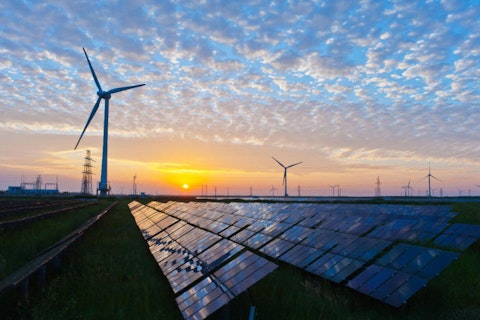In this article, we will be taking a look at the 20 most environmentally friendly states in America. If you wish to see the top ones, head straight to the 5 Most Environmentally Friendly States in America.
Climate change contributed to 18 weather disasters, including major hurricanes, wildfires, tornadoes, drought and a fierce winter storm, in the United States in 2022 that cost the country more than $165 billion in damages and claimed at least 474 lives, according to latest report from the National Oceanic and Atmospheric Administration (NOAA).
Most Americans are aware that their local communities are being impacted by global climate change either significantly or somewhat. Based on a new Pew Research Centre survey of more than 10,000 adults conducted this spring, 74% of Americans supported the United States taking steps to address global climate change and 67% backed an energy landscape that prioritizes renewable sources, like wind and solar, over the production of fossil fuels.
Renewable energy sources are rapidly emerging as a big player in the energy sector as the majority of businesses and countries globally aspire to achieve net zero carbon emissions by 2050 due to the problem of climate change, rising costs of conventional energy, and robust incentives that the developed world is offering to consumers of renewable energy products. We previously mentioned in one of our articles that according to the International Energy Agency (IEA)’s World Energy Investment report, investments in the global energy sector are anticipated to be around $2.8 trillion in 2023, of which more than $1.7 trillion is estimated to go to clean technologies. Additionally, it is projected that between 2021 and 2023, investments in green energy will increase by 24%, led by renewables and electric cars, as opposed to 15% for fossil fuels.
US Clean Energy Industry
Renewables are the fastest-growing energy source in the United States. Clean energy use grew by 42% between 2010 and 2020, making up 20% of utility-scale electricity production in the country. In addition, the country’s renewable electricity generation surpassed coal for the first-time last year, per the EIA data.
The federal statistical agency revealed that the growth in wind and solar significantly drove the increase in renewable energy, and contributed 14% of national power production in 2022, up from 12% the year before. Additionally, another 7% was added by hydropower, geothermal, and biomass, bringing the overall contribution of renewables to 21% in 2022, compared to 19% in 2021. At the same time, share of coal in power generation declined from 23% in 2021 to 20% in 2022.
Among individual states, Texas was the top wind-generating state last year, accounting for 26% of the national wind power. Following it were Iowa (10%), then Oklahoma (9%). Meanwhile, California, surpassed all other states in the production of solar energy. The state produced 26% of the national utility-scale solar electricity, followed by Texas and North Carolina, each with 16% and 8%, respectively.
Moreover, solar energy is expected to account for more than half (54%) of the 54.5 GW of new utility-scale electric generating capacity projected to be added to the American power grid this year, followed by battery storage (17%). This shows a noteworthy shift in favor of renewable energy and highlights the significance of sustainable energy solutions, driven by strong demand and the Inflation Reduction Act, signed by the Biden Administration last year, which directs around $400 billion to renewable energy in the form of funding and tax credits.
Adding to this, the United States’ progress on renewable energy differs from state to state, and not all of them share the same level of urgency to switch from fossil fuels to renewable energy sources in order to cut carbon emissions. Reducing utility costs is one of the main drivers for homeowners to switch to renewable energy. Although federal tax credits are available to customers in every state, but certain states also offer robust incentives, including tax credits, rebates, property tax exemption, and low interest loans, that make going solar even more appealing.
For instance, residents in New York can qualify for a 25% tax credit on solar installations (up to $5,000), and sales tax exemptions. Similarly, homeowners in the state of Idaho may qualify for a tax deduction of 40% of the cost of a solar system applied the year of installation, and 20% for the following three years. It also has a State Energy Loan program that offers low-interest loans for homeowners installing solar panel systems. Furthermore, Maryland offers a great selection of solar incentives. Residential Clean Energy Grant Program of the state, which offers up to $1,000 for home solar installations, is one such incentive.
Incentives like these benefit several companies like First Solar, Inc. (NASDAQ:FSLR) and Enphase Energy, Inc. (NASDAQ:ENPH), which provide solar energy solutions for domestic customers.
Don’t Miss: 10 Solar Stocks Billionaires are Loading Up On
First Solar, Inc. (NASDAQ:FSLR), Arizona-based solar company, designs, manufactures and sells PV solar modules. On July 27, First Solar, Inc. (NASDAQ:FSLR) posted earnings for the second quarter of 2023, reporting a GAAP EPS of $1.59, beating market estimates by $0.65. The revenue over the period was $811 million, up 30.6% compared to the revenue over the same period last year.
Enphase Energy, Inc. (NASDAQ:ENPH), headquartered in Fremont, California, is a provider of photovoltaic solutions, with a key focus on the residential market. The company beat market expectations on earnings per share in the second fiscal quarter. According to Insider Monkey’s second quarter database, 50 hedge funds were bullish on Enphase Energy, Inc. (NASDAQ:ENPH) and disclosed positions worth $772.7 million in the company.
Here is what Carillon Eagle Mid Cap Growth Fund had to say about Enphase Energy, Inc. (NASDAQ:ENPH) in its Q2 2023 investor letter:
“Enphase Energy provides solar microinverters and energy storage solutions. The company’s shares lagged benchmark counterparts amid concerns surrounding a near-term moderation in the growth of residential solar installation in the United States. Despite this, the company possesses a market-leading position in its core microinverter product and remains wellpositioned over the long term to benefit from ongoing solar adoption trends. Additionally, Enphase is focused on growing its international presence while also unveiling new products that could provide the next tailwind to its growth story.”
It is pertinent to note that California, widely regarded as a leader in renewable energy and particularly in solar power, passed new rules last year to cut the benefits on the use of rooftop solar panels. Analysts believe that this decision will have an impact on residential solar power companies as well as other states.
Some states give benefits to electrical vehicles buyers
When we talk about ways to cut carbon emissions, its important to remember that electric vehicles (EVs) are the key technology to decarbonize road transport. The IRA guarantees up to $7,500 in tax credits for EVs that are manufactured in America, but many states across the United States, though not all, also provide incentives for the purchase of electric cars in an effort to hasten the adoption of low-emission vehicles.
The Clean Vehicle Rebate Project (CVRP) in California, for example, provides tax credits ranging from $1,000 to $7,500 for the purchase of specific new EVs. Furthermore, New York’s Drive Clean Rebate program offers incentives of up to $2,000 for eligible new car purchases or leases. Similarly, Colorado offers great incentives. It’s rebate program called Excel gives buyers $5,500 upfront for purchase of new electric vehicles and $3,000 for used ones.
Sales of companies like Tesla, Inc. (NASDAQ:TSLA), a major dominating force in the EV sector, are being further boosted by states that offer generous EV benefits.
Tesla, Inc. (NASDAQ:TSLA) accounted for more than half of the 3,000 electric vehicles sold in the United States in the second quarter of 2023. As of September 6, the stock has returned 108.22% to investors on a year-to-date basis.
In its Q2 2023 Earnings Call, Elon Musk, CEO and product architect of Tesla, Inc. (NASDAQ:TSLA) said:
“In Q2 we achieved record vehicle production and deliveries, and record revenue of about $25 billion in a single quarter. And Model Y became the bestselling vehicle of any kind globally in Q1, surpassing the likes of Corolla and Golf. So, it was the number one vehicle of any kind, including vehicles that are sold at a far lower price. This is, I think, an incredible achievement by the Tesla team, and just a huge thank you to our customers for their support. And this came in spite of high interest rates and a lot of macro uncertainty. And nonetheless, we managed to achieve operating margin of about 10%. We continue to target 1.8 million vehicle deliveries this year. Although, we expect that Q3 production will be a little bit down because we’ve got summer shutdowns to — for a lot of factory upgrades.”
Most and Least Environmentally Friendly States in America
The 2023’s Greenest States study from the personal finance site, WalletHub, which ranked the 50 states utilizing 25 different metrics such as water quality, air quality, and renewable energy consumption, identified Vermont, New York, California, Hawaii, and Maryland as the top 5 most environmentally friendly states in the U.S. At the opposite end of the spectrum, the study ranked West Virginia, Louisiana, Mississippi, Alabama, and Wyoming as the least environmentally friendly states in the country.
Vermont, for example, generated almost 100% of its electricity from renewable resources in 2021. It also has low carbon dioxide emissions per capita. Similarly, California is a leader in the solar industry, and more than 1.5 million homes, businesses and other utility customers in the state have rooftop solar panels.
West Virginia, on the other hand, is more reliant on coal, which continues to supply the vast majority of the state’s electricity, delivering 91% of power in 2021.
With that said, let’s take a look at the most environmentally friendly states in America.
Our Methodology
We initially began our search for the most environmentally friendly states in America by using two reliable metrics. These included 2023’s Greenest States from WalletHub and ConsumerAffairs’s 2023 rankings for the Greenest States in the United States.
We then proceeded to assign a score to each state based on its ranking in each report. For instance, the #1 state in each report will get a score of 50/50=1, #2 state will get a score of 49/50=0.98 and so on.
After that, we added the scores from these two reports for each state. The top 25 states along with their scores were shortlisted, creating a list A.
We then applied the same scoring methodology to the third metric, our recently published analysis on the 20 States with the Most Electric Vehicles, to generate a list B.
The overall score for each state was calculated by adding up their individual scores in the aforementioned lists. Finally, we sorted the states by their overall scores and identified the 20 most environmentally friendly states in America.
20. North Carolina
Overall Score: 1.28
North Carolina, in the Southeastern region, is one of the most environmentally friendly states in America on our list. It had around EV 45,590 registrations in 2022.
19. Idaho
Overall Score: 1.32
According to the EIA, renewable energy sources accounted for 75% of all power generated in Idaho last year.
18. Virginia
Overall Score: 1.39
Virginia is ranked third in the nation for overall air and water quality, according to the 2023 U.S. News & World Report’s annual Best States rankings.
17. Delaware
Overall Score: 1.40
Delaware, a Mid-Atlantic U.S. state, encourages homeowners and companies to use renewable energy by providing grants, incentives, and technical assistance. Solar currently accounts for roughly 4.5% of the state’s electricity, which is enough to power about 30,000 homes.
In addition, Delaware intends to triple its solar capacity during the next five years.
16. Hawaii
Overall Score: 1.61
Hawaii, located in the middle of the North Pacific Ocean, is one of the most environmentally friendly states in America. It has the finest air quality among the 50 states, according to WalletHub research. Additionally, the state has second lowest gasoline consumption (in gallons) per capita.
15. New Hampshire
Overall Score: 1.62
New Hampshire has cut air emissions by 76% in the last decade, per the EIA.
14. Minnesota
Overall Score: 1.67
Based on recent research from ConsumerAffairs, Minnesota, located in the Midwest region, is among the top 10 greenest states in America. Moreover, renewables provided 31% of the states’ electricity generation in 2022, per the EIA.
13. South Dakota
Overall Score: 1.68
South Dakota is one of the most environmentally conscious states in America. Residents of the state have access to financial incentives to encourage the use of renewable energy.
In 2021, the state produced the second-highest percentage of energy from renewables.
12. Connecticut
Overall Score: 1.69
Connecticut Green Bank, established in 2011, invests in clean energy projects and helps residents and businesses in financing renewable energy projects, thereby making them more affordable.
11. Maine
Overall Score: 1.76
Maine is on track to generate 100% of its electricity from renewables by 2040. Also, this eco-friendly state has the second-lowest amount of landfill waste among the 50 states.
10. Nevada
Overall Score: 1.97
Nevada, a state in the Western region of the United States, had a total of 32,950 EV registrations in 2022.
9. Vermont
Overall Score: 2.00
Vermont, one of the greenest states in America, recently passed the Affordable Heat Act, which aims to reduce dependence on high-cost, price-volatile, and polluting fossil heating fuels.
8. New York
Overall Score: 2.01
According to WalletHub’s report on 2023’s Greenest States, the State of New York uses the least amount of gasoline per capita in the country.
7. Massachusetts
Overall Score: 2.04
Massachusetts encourages individuals and business owners to adopt sustainable energy through implementing climate-friendly policies. In 2021, 20% of all electricity produced in the state came from solar.
6. Colorado
Overall Score: 2.07
Colorado, with 10.3 electric vehicle registrations per thousand residents in 2022, is one of the most environmentally friendly states in America.
Click to continue reading and see 5 Most Environmentally Friendly States in America.
Suggested articles:
- 15 Most Bike Friendly Cities in the US
- 25 Most Environmentally Friendly Companies in the World
- 25 Best Countries for Green Living
Disclosure: None. 20 Most Environmentally Friendly States in America in 2023 in 2023 is originally published on Insider Monkey.





